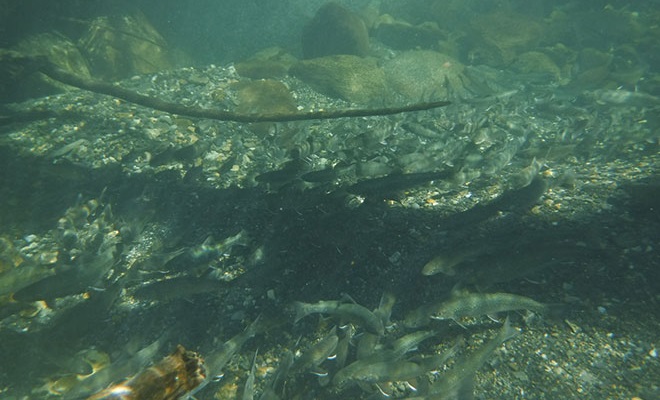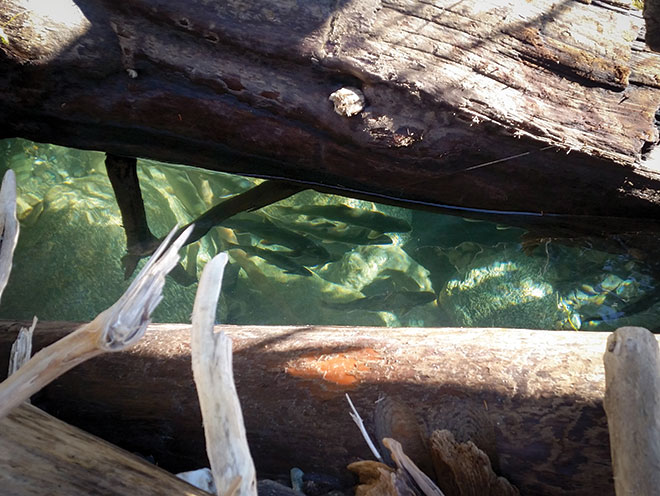Water Temperatures Blog by Eric Booton
Photos by Mark Hieronymus

Intact, complex fish habitat is integral to the survival of fish during inclement conditions.
Water Temperatures: Too Hot to Handle? Fishing in a Warming Alaska
When it comes to freshwater fishing in Alaska, we are fortunate to have a wealth of destinations hosting a wide array of species, all with their own unique draw. Fall dollies with their vibrant colors, high-jumping and hard-fighting rainbows, and the tenacious battling Chinook are about as different as it gets in terms of target species, but they (along with the rest of Alaska’s salmon, trout and char) all share one thing—they’re cold-water fish species. With deep snowpacks and expansive glaciers, it’s no surprise that cold-water fish have thrived throughout Alaska. The chilly runoff flows have sustained these species, which require cold, clean water in all of their life stages. However, recent trends draw into question the resilience of these world-class fisheries that the Last Frontier is famous for and leaves many anglers with a feeling of helplessness.
The human world may be finally righting itself after an exhausting year but with the warmth of summer, and the heart of fishing season on the way, it’s important to reflect on recent trends that significantly affect our finned friends in their underwater world.
While it feels so long ago, let’s take a quick trip back to 2019. Categorized as an “un-seasonable summer,” 2019 was an alarming, and in several instances, disastrous year for salmon and cold-water fisheries in Alaska. Like many southcentral Alaska anglers, I was caught between a rock and a hard place. Or, more accurately, sandwiched between blazing wildfires and a dire combination of low flows and warm water temperatures that, in some instances across the state, were lethal to fish.
For those who weren’t wetting a line during the summer and fall of 2019 in southcentral Alaska, here is the quick recap. The famous Kenai River and Susitna River were entrenched in numerous wildfire battles as a result of extreme drought. Guides were choking on thick smoke while entertaining the clients willing to brave the unpleasurable conditions, popular sportfishing destinations were closed and anglers were scrambling for alternative locations to fish.

Char seek cover in the safety of a log jam during a low-water event at the start of the spawning season.
But, many of the logical alternative options for anglers in the area were experiencing their own unique challenges. With a record dry summer, non-glacial rivers and streams were reduced to mere trickles and were more susceptible to warming due to record air temperatures. On the Deshka River, scientists recorded water temperatures in excess of 80ºF (water temperatures in excess of 55ºF are stressful to cold-water fish).
The impacts were plain as day. Routinely floatable creeks were not navigable, large rainbow trout were turning up dead, and salmon were reluctant to abandon the refuge and safety of the cooler glacial waters. Alaskans who’d lived in the area for decades claimed it was unlike anything they’d witnessed. Catch-and-release sportfishing was not a safe practice and migrating salmon were too stressed to warrant harvest; simply getting them on spawning beds was the priority.
Impacts of the drought and record temperatures were not limited to Southcentral, and mass die-offs of salmon were observed in several locations, including Bristol Bay, Norton Sound and the Kuskokwim. Most notably, on the Koyukuk River, scientists counted 850 dead, unspawned chum salmon, and that was just the prematurely perished salmon they could find.
Warm, stressful temperatures also change the behavior of fish. It has been observed that warm and low freshwater conditions led to both physiological and behavioral responses by adults of all five species of wild Alaska salmon and impacted commercial, sport and subsistence fishermen. At this point, impacts to egg and juvenile life stages are unknown.
Warming water trends are no surprise to scientists. In fact, after years of monitoring, they have already witnessed significant warming trends to the tune of an average of .5ºF per decade since 1980 in non-glacial streams of Cook Inlet (Schoen, et. al., 2018). What has been surprising to fisheries scientists in Alaska is the rate at which these streams are warming. At the 2019 Mat-Su Salmon Symposium, Cook Inletkeeper’s Science Director, Sue Mauger, reported that we reached, or exceeded, the maximum stream temperature values in the Cook Inlet basin that were predicted to be observed 50 years out into the future. Climate change has hit Alaska’s salmon streams. This is our reality, and we can anticipate more wildfires, droughts, limited flows, and alarming stream temperatures.
While combating climate change and increasing water temperatures is largely outside of our control, there’s no shortage of actions anglers can take to mitigate risk and look out for the future of our finned friends.
Limit Stressors
If you are practicing catch-and-release, fish barbless hooks, use a net, keep the fish in the water, and use a properly stout rod and line to minimize the duration of the fight. But if water temperatures exceed safe levels for fish, proper catch-and-release is not enough and seeking out other fishing opportunities is the best choice.
Advocate for Clean Water & Healthy Habitat
It’s simple: Alaska’s cold-water fisheries need healthy habitat and clean water to survive. Poor-quality water and habitat act as an additional, and avoidable stressor that can make cold-water fish increasingly susceptible to the whims of warm water. Fish habitat isn’t just the water and wetlands in which fish reside. Fish habitat also includes the adjacent riparian areas that not only keep stream banks intact, but provide the cover of shade and help maintain suitable conditions. A well-built home is most likely to withstand a storm; similarly, with access to favorable habitat and water, cold-water fish have a stronger chance of surviving stressful water temperatures.
Protect Sources of Cold Water
Without the influence of cold water from melting ice, non-glacial river systems and tributaries are most vulnerable to both lethal water temperatures and low stream flow. Within rivers and streams there are localized patches of cold water from ground water and other cold-water sources. These influences of cold water need to be preserved to better combat warming water temperatures and provide cooler areas within streams where fish can congregate during warm temperatures.
Support Regulations that Benefit Fish
Local, state and federal governments are continually weighing ordinances and regulations. Supporting the ones that help benefit fish and their habitat as an individual and a homeowner is an easy way to help craft a system that proactively protects fish habitat, avoids degradation and costly restoration.
Fishing is a balance of the thrill and adventure of the pursuit of the wild, and stewardship of it. It’s easy to track the annual concerns of fish returns and isolated threats of non-fish-friendly development projects. However, it is more challenging to follow, understand, and see where we can make a splash in such a vast and nearly covert threat to our fisheries as climate change. At the end of the day, education and individual actions are amongst our best tools in our tackle box as anglers; a burden to some, but a moral duty to many.
The Mat-Su Salmon Habitat Partnership, the Great Land Trust and more have created useful guides for living next to salmon streams and educational materials on the importance of riparian areas. Please contact Trout Unlimited to be connected with the resources that may be most helpful to you.
Eric Booton, Trout Unlimited Alaska
This blog originally appeared as the Conservation column in the June 2021 issue of Fish Alaska, titled ‘Too Hot to Handle: Fishing in a Warming Alaska.’


